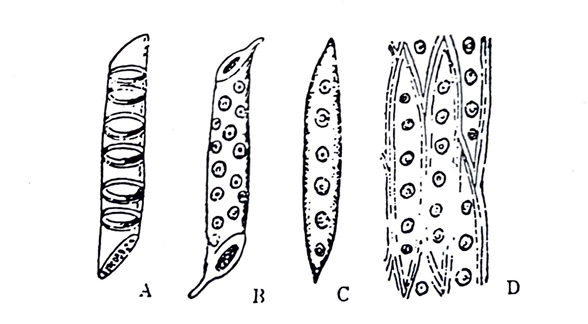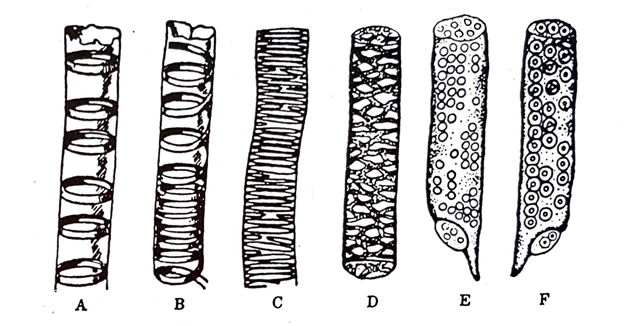A complex tissue is made up of more than one type of cell-elements, which work together as a unit. There are two types of complex tissues:
- Xylem tissues
- Phloem tissues
which constitute a vascular bundle, the conducting system of the plant.

Fig. 8: Tracheids. A, tracheid with annual thickening; B-D, tracheids with bordered pits. (After Bhuya & Timm}.
Xylem Tissues
Xylem or wood is a typical complex tissue and constitutes the major portion of the vascular bundle. It is composed of the following elements:
- Tracheids
- Vessels or tracheae
- Wood fibres
- Wood parenchyma
Tracheids
Tracheids are elongated cylindrical cells with hard, thick and lignified walls, large lumen and tapering end. Their walls are provided with one or more rows of bordered pits. Depending on the thickening of the. walls the tracheids may be annular, spiral or scalariform with simple pits. In the wood of ferns and palms tracheids occur alone whereas in the wood of higher plants they occur associated with the vessels. Tracheids conduct water as well as give mechanical strength to the plant.

Fig. 9: Vessels. A, annular; B. spiral, C, scalariform; D. reticulate; E, with simple pits; F, with bordered pits (Reproduced from Dutta).
Vessels or Tracheae
They are elongated tubular pipe-like structures, formed of a row of cells placed end to end by the dissolution of their transverse partition walls. The longitudinal walls of the vessels are lignified and thickened in various ways. According to the mode of these thickenings, the vessels are variously named, such as annular vessels, when the thickening takes place in the form of rings on the interior of the original wall spiral vessels, then the thickening takes the form of a spiral band scalariform vessels, when the thickening material is deposited transversely on the inner side of the wall in the form of rods or rung of a ladder reticulate vessels, when the thickening takes the form of a network, leaving a number of irregular unthickened spaces on the wall and pitted vessels, when the whole inner surface of the wall is almost uniformly thickened, leaving small unthickened areas or cavities here and there. These unthickcned areas are called pits, which are formed in pairs lying against each other on the opposite sides of the wall. Vessels serve for conduction of water and mineral salts from the roots to the leaves and give mechanical strength and support to the plant body.
Wood fibres
Sclerenchymatous fibrous cells associated with other xylem cells are called wood fibres. They occur abundantly in most woody plants and add to the mechanical strength of the xylem tissue.
Wood parenchyma
Some parenchymatous cells also occur frequently in the vascular bundles along with other xylem cells. These parenchymatous cells are known as wood parenchyma. These are living and thin-walled cells
Phloem Tissues
The phloem is also a complex tissue formed along with the xylem as a part of the vascular bundles. It is composed of thin-walled cells and its main function is to conduct prepared food materials, especially sugars and proteins. It is composed of
- Sieve tubes
- Companion cells
- Phloem parenchyma
- Bast fibres.
Sieve Tubes
These are slender, tube-like structures composed of elongated, thin-walled cells, placed end to end. Their transverse partition walls, perforated by a large number of pores as in sieves, are called sieve plates. Although living, the sieve tubes do not possess any nucleus, but their cytoplasm is continuous through the pores .of the sieve-plate. During winter the sieve-plate is covered on both the surfaces by a carbohydrate substance, callose, forming a pad. This pad is known as callus-pad. The callus-pad closes the perforations, and consequently, the sieve-plate ceases to function. During the next growing season, the callus-pad is dissolved and the sieve-plate resumes its function of transmission of food materials from the leaves to the storage organs and growing regions of the plant.
Companion Cells
These are long, narrow and thin-walled cells found associated with the sieve tubes, and are connected with them through some pores. Each companion cell contains dense cytoplasm and a prominent nucleus. They occur only in the higher plants (Angiosperms) and assist the sieve tubes in the conduction of food material.

A Sieve-tubes, companion cell and phloem parenchyma in l.s.; B, a sieve tube (showing sieve-plate) and a companion cell in t.s. (Reconstructed from Dutta).
Phloem Parenchyma
Some parenchymatous cells always occur as part of the phloem in all plants, and these constitute the phloem parenchyma. These cells are all living and active. They are vertically elongated. Their principal functions are storage of proteins and transportation of food matter transversely from the sieve tubes to the medullary rays and the xylem.
Bast fibres
Some sclerenchymatous cells sometimes occur in the secondary phloem (bast) of some plants, e.g. the bark of Cinchona species. These cells are known as bast fibres as they assume the shape of fibres
Pharmacognostical importance of phloem tissues
Position of the phloem in the plant body often offers important anatomical characters in the microscopic examination of some plant drugs. Normally, in the stems of angiospermic plants the phloem lies external to the xylem. But in some families of medicinal plants, such as Solanaceae, Apocynaceae, Myrtaceae, Convolvulaceae Compositae, etc., a part of the primary phloem, called the intraxylary phloem, occurs internal to the primary xylem around the pith. Sometimes small groups of secondary phloem, called the interxylary phloem, are found embedded in the secondary xylem of some plants, such as Strychnos nux-vomica, combretum; Agave and Aloe species. In addition, as mentioned before, occurrence of bast fibres is characteristic of some drugs.
